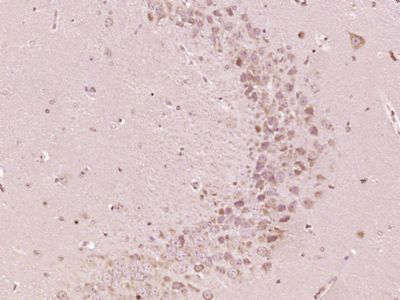产品货号 : mlR17532
英文名称 : Otoferlin
中文名称 : 耳聋相关蛋白NSRD9抗体
别 名 : AUNB1; Deafness, autosomal recessive 9; DFNB6; DFNB9; Fer 1 like protein 2; Fer-1-like protein 2; FER1L2; NSRD9; Otof; OTOF_HUMAN; Otoferlin.
研究领域 : 细胞生物 发育生物学 神经生物学
抗体来源 : Rabbit
克隆类型 : Polyclonal
交叉反应 : Human, Mouse, Rat, Dog, Cow, Horse,
产品应用 : ELISA=1:500-1000 IHC-P=1:400-800 IHC-F=1:400-800 ICC=1:100-500 IF=1:100-500 (石蜡切片需做抗原修复)
not yet tested in other applications.
optimal dilutions/concentrations should be determined by the end user.
分 子 量 : 227kDa
细胞定位 : 细胞浆
性 状 : Lyophilized or Liquid
浓 度 : 1mg/ml
免 疫 原 : KLH conjugated synthetic peptide derived from human Otoferlin:1601-1700/1997 <Cytoplasmic>
亚 型 : IgG
纯化方法 : affinity purified by Protein A
储 存 液 : 0.01M TBS(pH7.4) with 1% BSA, 0.03% Proclin300 and 50% Glycerol.
保存条件 : Store at -20 °C for one year. Avoid repeated freeze/thaw cycles. The lyophilized antibody is stable at room temperature for at least one month and for greater than a year when kept at -20°C. When reconstituted in sterile pH 7.4 0.01M PBS or diluent of antibody the antibody is stable for at least two weeks at 2-4 °C.
PubMed : PubMed
产品介绍 : Mutations in this gene are a cause of neurosensory nonsyndromic recessive deafness, DFNB9. The short form of the encoded protein has 3 C2 domains, a single carboxy-terminal transmembrane domain found also in the C. elegans spermatogenesis factor FER-1 and human dysferlin, while the long form has 6 C2 domains. The homology suggests that this protein may be involved in vesicle membrane fusion. Several transcript variants encoding multiple isoforms have been found for this gene. [provided by RefSeq, Jul 2008]
Function:
Key calcium ion sensor involved in the Ca(2+)-triggered synaptic vesicle-plasma membrane fusion and in the control of neurotransmitter release at these output synapses. Interacts in a calcium-dependent manner to the presynaptic SNARE proteins at ribbon synapses of cochlear inner hair cells (IHCs) to trigger exocytosis of neurotransmitter. Also essential to synaptic exocytosis in immature outer hair cells (OHCs). May also play a role within the recycling of endosomes.
Subcellular Location:
Cytoplasmic vesicle > secretory vesicle > synaptic vesicle membrane. Basolateral cell membrane. Endoplasmic reticulum membrane. Cell membrane. Detected at basolateral cell membrane with synaptic vesicles surrounding the ribbon and at the presynaptic plasma membrane in the inner hair cells (IHCs). Colocalizes with GPR25 and RAB8B in inner hair cells.
Tissue Specificity:
Isoform 1 and isoform 3 are found in adult brain. Isoform 2 is expressed in the fetus and in adult brain, heart, placenta, skeletal muscle and kidney.
DISEASE:
Defects in OTOF are the cause of deafness autosomal recessive type 9 (DFNB9) [MIM:601071]. DFNB9 is a form of sensorineural hearing loss. Sensorineural deafness results from damage to the neural receptors of the inner ear, the nerve pathways to the brain, or the area of the brain that receives sound information.
Defects in OTOF are a cause of non-syndromic auditory neuropathy autosomal recessive (NSRAN) [MIM:601071]. NSRAN is a form of sensorineural hearing impairment with absent or severely abnormal auditory brainstem response but normal otoacoustic emissions. Auditory neuropathies result from a lesion in the area including the inner hair cells, connections between the inner hair cells and the cochlear branch of the auditory nerve, the auditory nerve itself and auditory pathways of the brainstem. In some cases NSRAN phenotype can be temperature sensitive.
Similarity:
Belongs to the ferlin family.
Contains 4 C2 domains.
SWISS:
Q9HC10
Gene ID:
9381
Important Note:
This product as supplied is intended for research use only, not for use in human, therapeutic or diagnostic applications.
产品图片












